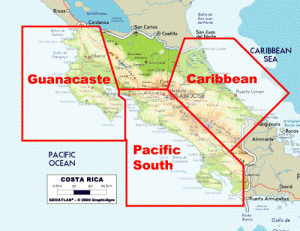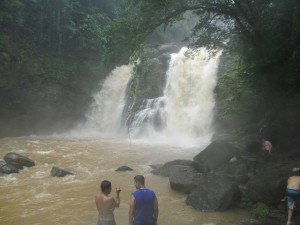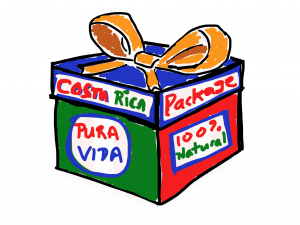One of the most frequent questions I get from Package Costa Rica customers (or potential customers) is, hey, CRG, what’s the weather like? Or, a variation, such as, we were thinking of coming in x or y (month), is that a good time to come, weather-wise?
I usually provide a curt and self-serving answer like “well, any time is a good time to come to Costa Rica.” And for the most part, that’s true. But we do have weather. It does rain. And there are some seasonal differences. So I thought I would do a post today on the topic of Costa Rica climate.
A Tale of Two Coasts with a Mountainous Spine
Like the U.S., Costa Rica has a west coast (the Pacific) and an East Coast (the Caribbean). However, unlike the U.S., our two coasts are only hours (not days) apart. They are divided by a mountainous spine consisting of the Talamanca, Central, Tilaran and Guanacaste mountain ranges. These mountains slope to the Pacific on one side and to the Caribbean on the other. The small size of Costa Rica might lead someone to think that the weather would not be that different on one slope than it is on the other. Wrong! The Pacific slope and the Caribbean slope have different weather patterns. On the Pacific, the rainy season starts in May and runs through November. On the Caribbean, the rain comes a little earlier (April) and sticks around though December. Also, the Caribbean experiences a brief period of dry weather, a veranillo, usually occurring in September and October. In contrast, these can be two of the months with the most rain on the Pacific side.
Seasonally Speaking
In Costa Rica we have only two seasons. The summer (or dry) season (Verano) and the winter (or rainy) season (Invierno). The previous paragraph explained the degree those seasons differ whether you are talking Pacific or Caribbean slope. Rainfall amounts differ dramatically with the seasons. However, temperature is fairly constant year around and varies much more by altitude than by season. The coolest months of the year actually are some of the driest ones of January, February and March, when the trade winds tend to blow the hardest.
Geographical Gyrations
The effects of the seasons vary for each major geographical division. For instance, the northern half of the country on the Pacific slope, consisting primarily of the province of Guanacaste, experiences the most intense dry season with very strong winds and virtually zero precipitation. The Central Valley, where the capital city of San Jose is located, experiences the mildest weather patterns. This is why it is the most populated area of the country. Temperatures are mild throughout the year and the rainy season is not as intense as in other areas. The southern half of the Pacific slope experiences a shorter dry season and a longer and more intense rainy season.
Temperatures in Costa Rica can very considerably by altitude, if not by season. At the summit of peaks as high as Chirripo (3,820 meters above sea level) you can actually get morning frost. At the same time, down at sea level on the Pacific or Caribbean the temperatures remain hot and humid throughout the year. The most moderate temperatures are felt in the central valley, which enjoys an almost eternal spring-like climate.
Rain, Rain, Go Away
The evil demon that our customers always want exorcised from their vacations is rain. But wait a minute. One has to realize that without the rain, there is no Costa Rica. At least, not the Costa Rica that beckons 2,000,000 tourists per year to its lush green jungles and mountains teaming with flora and fauna. So, if you want to come to Costa Rica and are adamant about no rain, then opt for Guanacaste in the months of January through April. But up there you won’t see lush green tropical jungles because it is just too darn dry. For that you need to go South or East. Rainfall is more prevalent in those areas, hence their spectacular greenness, but it is still predominantly dry on the Pacific and Caribbean slopes for the months of January through March. You can have a dry Caribbean experience in August, September or even October, which is in stark contrast with the rest of the country where it is likely raining cats and dogs.
But dry season also brings crowds and higher prices. To avoid those, you might want to consider the green (or rainy) season. If you do, don’t fret too much about rain since it usually consists of afternoon showers that start around mid-afternoon and last until dusk. Mornings are typically sunny and nights clear. On the Pacific Slope, the rainiest months, when one can really experience endless days of constant downpour, are September and October. So, if those are the months when you want to come, consider our Arenal and Puerto Viejo design, or our Costa Rica Caribbean design, as an alternative.
The Unruly Child – El Niño
Costa Rica experiences a recurring weather phenomenon about every two to seven years (although it seems more frequent lately). It is generally detectable by an unusual warming of Pacific ocean waters. This little bugger can really turn normal weather patterns on end. When it occurs (the last time was actually last year), the rainy season is a lot dryer than normal on the Pacific slope. It also can wreak major havoc on Caribbean slope weather, with a wetter than average winter. With El Niño, things go a little haywire and are far more unpredictable than is the norm.
I hope this little post on Costa Rica climate helped calm your Costa Rica vacation-related weather anxiety. I am no weather expert, so I may have gotten something wrong above. If there are any meteorologists out there who want to take issue, or elaborate, on anything written above, by all means do so.
Post by CRG
Source: Technical mumbo jumbo gleaned from the World Headquarters Report on Costa Rica Climate.



